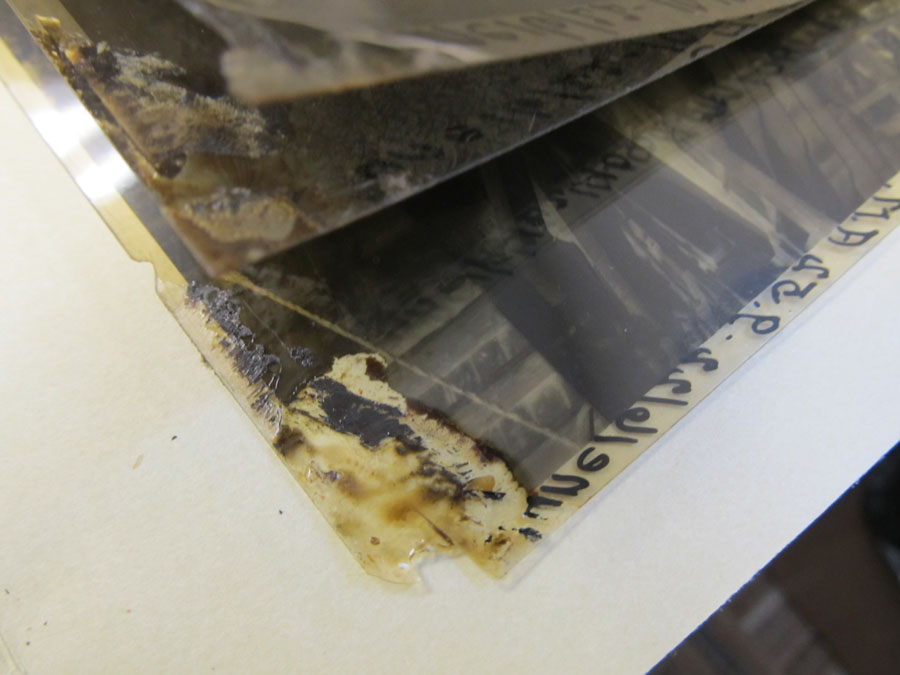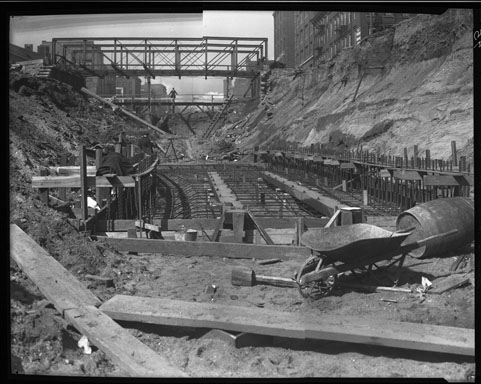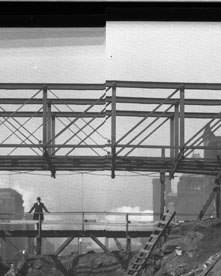By: Angela Vanderbilt
Digitally preserving eighty-year-old negatives and prints for online access requires clear guidelines and close attention to detail to ensure all information contained in the photographic records is captured. Such a project also requires careful organization of the physical collection so that all assets may be accounted for through each stage of the project. Finally, close inspection of the digital rendering is necessary to ensure the highest quality of scanned images is obtained and preserved for future use.
Due to the unstable nature of the negatives, safe handling of the physical material is a priority both during the organization phase of the project at the Archives & Rare Books Library, as well as during the scanning phase at Robin Imaging Services. Proper handling will not only protect the physical condition of the negatives and prints, but of those handling them, as well! While organizing the collection, I wear cotton gloves to avoid contact with the negatives and a filtered mask to avoid breathing in any fumes that the negatives may be putting off as they deteriorate. I also use a metal spatula to lift and separate each individual negative. This allows me to create an itemized list of each asset in a spreadsheet, which will be used to generate the metadata that is required to build the online collections. It will also give us a final tally on total number of negatives and prints contained in the collection.
A full-service photographic lab experienced with handling a wide range of formats, including our delicate silver-nitrate, was selected to safely scan all negatives and prints. To ensure safe handling, Robin Imaging has prepared a separate lab within their facility dedicated to this project alone, and assigned highly trained photographic technicians to handle the sensitive negatives and prints. All black & white negatives and prints will be scanned at 600 ppi, 8-bit grayscale, and saved in TIFF format using equipment that operates at a low temperature in a lab with good ventilation to avoid damaging the heat-sensitive negatives. The output settings selected will produce a very detailed image that may be enlarged or reduced at a clear resolution. Lower-resolution images may then be generated from this base file. All scanned images will be numbered in sequential order, with other unique identifiers that indicate the box and folder numbers within which the original asset was located. This information will be entered into a spreadsheet along with any information that has been hand-written on the negative or print surface, both front and back.
Occasionally, the negatives are stuck together due to deterioration. I do not attempt to separate any negatives that are sticking together, since this may damage the emulsion and destroy information in the photograph. Robin Imaging Services will apply the necessary procedures to safely separate these negatives and avoid damaging the image. Generally, this may be as simple as slipping the negatives into a water bath to remove residue, as would have been done when the negatives were first developed. They will then be dried completely before being scanned.
Scanning is being completed on a 2-week cycle. When one “batch” of boxes (usually 3, containing approximately 250 negatives) is completed and returned to ARB, another “batch” of boxes is picked up for scanning. A spot-check of the scanned images and the spreadsheet is done to review quality and ensure any handwritten information is being accurately transcribed from the files. The 8×10 negatives have a very wide tonal range, and occasionally one of the images needs to be rescanned. Sometimes it’s a very slight recalibration of the scanner that is needed. The images below show how slight an issue may be with a scan, but our goal is to provide the highest quality of detail for library patrons, and so any scans that do not meet quality standards are reprocessed.
 This project is funded by a grant for $60,669 through the Library Services and Technology Act, administered by the State Library of Ohio.
This project is funded by a grant for $60,669 through the Library Services and Technology Act, administered by the State Library of Ohio.




